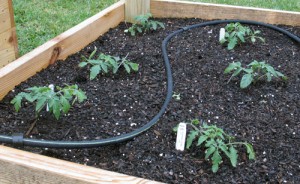Posted by Aimee | Posted in Compost, Raised Beds, Soil | Posted on 01-12-2010
Tags: chicken manure, Compost, fertilizer, garden beds, garden books, good soil, important things, kelp meal, Microlife, peat moss, proportions, soil amendments, soilless mix, square foot gardening, vermiculite, worm castings
One of the most important things to do when starting your plants is to make sure that the soil they will be raised in is as good as you can make it. This often means making amendments to the soil or creating a soilless mix for the plants to grow in.
Having a good soil for your plant can often double or triple your harvest and often means the difference between a plant thriving or dying. For my plants I start with the same base every time, then expand to their specific needs. If it is going to be in my garden beds, I mix the soilless mixture in equal parts with my present soil, optimally to a depth of 12 inches.
I cannot claim full credit for my soilless recipe as it got it’s start by reading various garden books and trying different combinations. The one I chose ended up being very close to the one Mel Barthalowmew uses in his “Square Foot Gardening” series.
The key components to this mix are as follows: Coarse grade vermiculite, peat moss, compost, composted chicken manure, MicroLife fertilizer, soil moist, kelp meal, fish meal, and worm castings. These soil amendments combined make an absolutely fantastic soil. If you cannot get all of these ingredients you can still have good soil but each amendment has key benefits that I will go into further detail in our next post.
The recipe itself is pretty easy, I use an old, clean, five gallon bucket as a measure. An old gallon milk jug with the top cut off works pretty well too. Mixing the ingredients on a tarp works well if you have someone to help you mix. Otherwise in a wheelbarrow with a shovel is your next best option. You can enlarge or shrink your batch as you desire just keep the soil amendments in the same proportions. First measure out 1 bucket of each: vermiculite, peat moss, & compost.
The other soil amendments are more expensive and so I usually have less of a supply of them but you cannot have too much of the chicken manure or worm castings so that is what you want the bulk of it to be. Next, fill your bucket half full or more of composted chicken manure, Then add your worm castings to the bucket leaving about 1 gallon of space left (Total composted chicken manure and worm castings of 4 gallons.)add 1 cup of Microlife, 1 cup of soil moist, and then split the remaining room between the ground sea kelp and fish meal. Add this last bucket full to your pile of vermiculite, peat moss, & compost.
Mix the pile together thoroughly and then use as is for potted plants or raised beds or mix in equal parts with your soil. If your soil is very, very sandy, I recommend the addition of more compost (another bucket full). If your soil is mostly clay I suggest the addition of a bucket full of green sand (agricultural sand.)
This base has proved to me to be an excellent choice both indoors and out, my plants have thrived and I only add more compost and Microlife on occasion. You can also tailor this mix to your specific plants likes. Please feel free to contact me with any questions you may have.

